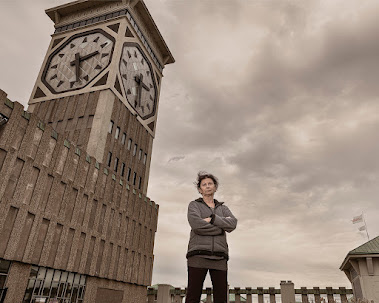How deindustrialization changed the economy & spirit of Milwaukee
Lake Effect, WUWM — Milwaukee's NPR
Following is the transcript of the interview on May 16, 2023.
Milwaukee was once known as the “Machine Shop of the World,” and for writer and artist Barbara Miner, that was very much true for her growing up here at the height of the Civil Rights movement when we were a manufacturing powerhouse.
Miner left Milwaukee for 20 years before returning in the 80s to raise her family, but she noticed a significant change not only in the physical landscape but in the spirit of the city after deindustrialization.
Factories closed and turned into strip malls, office buildings or apartments, and union jobs that supported many families were gone — setting off major changes to Milwaukee and its economy.
Miner examines the impact of this shift in her new multimedia project, Shadows of Industrialization. Through photographs and audio interviews, the project looks at contemporary Milwaukee through its former factories and the people who worked there.
Milwaukee's industrial strength and prominence in 1970 were demonstrated through the top ten employers in the city that year, being either factories or breweries according to Miner. During this time, Milwaukee was one of the best places for middle-class and Black families. Earl Ingram Jr., one of the subjects from the project, recounts his experience living and working in Milwaukee and the transition that has since occurred:
"Milwaukee had the highest standard of living for Black people in this nation in the mid to late 1970s and the early 1980s. The highest standard of living ... includes Atlanta, that includes Houston ... In a 40-year period [Milwaukee went] from the best place in the nation to live to now, arguably, one of the worst," says Ingram.
Listen to Early Ingram Jr.'s interview from Barbara Miner's project, "Shadows of Industrialization."
In addition to the multiple interviews and first-hand accounts that Miner pursued and collected for this project, she also thought it was important to incorporate photographs of the areas discussed in the project.
"I knew I wanted to photograph the people who worked in the industry, but because it was also the story of Milwaukee, I wanted to photograph them in the locations where they had worked," notes Miner.
Many areas that once housed these prominent pillars of employment and economic stability are either abandoned or have been demolished and replaced. "To me it just symbolized the emptiness of what happened when those jobs left," she adds.
Miner notes that unionization helped make this economic style stronger while it was still in the prime of its power. Industrial and mechanical work was often tough on the body and required organized support to perform at high levels, and many of the subjects she spoke with specifically worked at companies with unions. But eventually, the incorporation of public transportation limitations significantly altered the employment opportunities for many Milwaukee residents. As many companies moved to suburbs where Black Milwaukeeans in particular could not follow, it helped contribute to what is now described as "hyper-segregation" in the city's workplace and makeup.
— Barbara Miner

